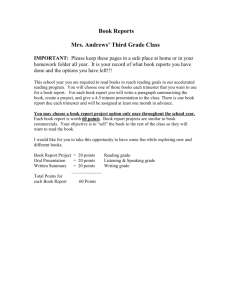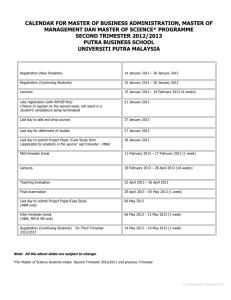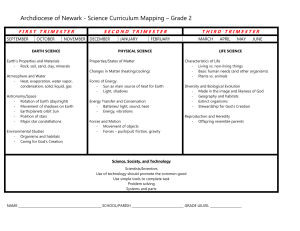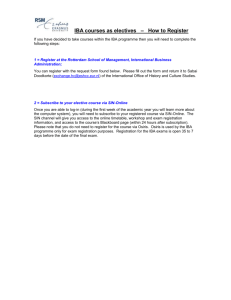1 - WordPress.com
advertisement
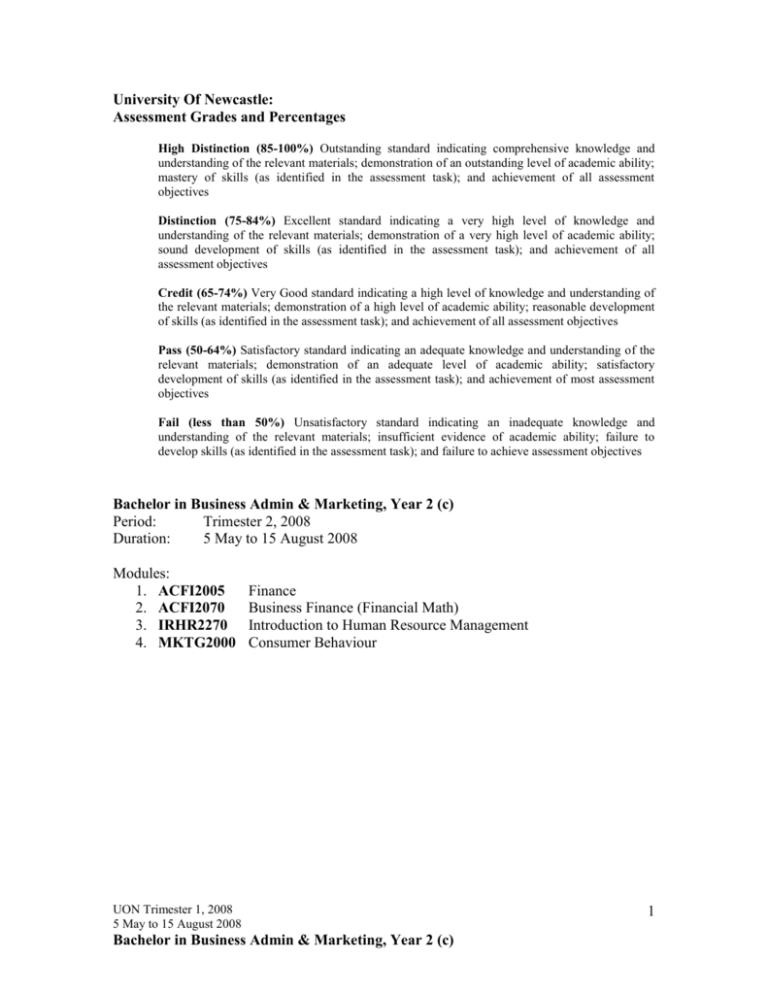
University Of Newcastle: Assessment Grades and Percentages High Distinction (85-100%) Outstanding standard indicating comprehensive knowledge and understanding of the relevant materials; demonstration of an outstanding level of academic ability; mastery of skills (as identified in the assessment task); and achievement of all assessment objectives Distinction (75-84%) Excellent standard indicating a very high level of knowledge and understanding of the relevant materials; demonstration of a very high level of academic ability; sound development of skills (as identified in the assessment task); and achievement of all assessment objectives Credit (65-74%) Very Good standard indicating a high level of knowledge and understanding of the relevant materials; demonstration of a high level of academic ability; reasonable development of skills (as identified in the assessment task); and achievement of all assessment objectives Pass (50-64%) Satisfactory standard indicating an adequate knowledge and understanding of the relevant materials; demonstration of an adequate level of academic ability; satisfactory development of skills (as identified in the assessment task); and achievement of most assessment objectives Fail (less than 50%) Unsatisfactory standard indicating an inadequate knowledge and understanding of the relevant materials; insufficient evidence of academic ability; failure to develop skills (as identified in the assessment task); and failure to achieve assessment objectives Bachelor in Business Admin & Marketing, Year 2 (c) Period: Trimester 2, 2008 Duration: 5 May to 15 August 2008 Modules: 1. ACFI2005 2. ACFI2070 3. IRHR2270 4. MKTG2000 Finance Business Finance (Financial Math) Introduction to Human Resource Management Consumer Behaviour UON Trimester 1, 2008 5 May to 15 August 2008 Bachelor in Business Admin & Marketing, Year 2 (c) 1 ACFI2005 Finance GENERAL COURSE INFORMATION Brief Course Description This course provides students with an introduction to the Australian financial markets and an evaluation of the institutions, instruments and participants involved in the industry. The markets to be evaluated include the equity, bond, futures, and options markets. The course systematically reviews each of these financial markets and examines the various institutional participants and the different types of financial instruments offered. Assumed Knowledge: Nil Course Objectives / Learning Outcomes On successful completion of this course, students will be able to: Have an overview of the Australian financial system 1. Understand how securities are traded 2. Understand how securities are valued 3. Have knowledge of the operations of the equity, bond, futures and options markets 4. Use basic financial mathematics; 5. Identify the basic instruments of corporate funding 6. Have knowledge of futures and options markets Course Content Lectures will include, but may not be restricted to, the following topics: 1. An overview of the financial system 2. The share market and corporations 3. Corporations issuing equity in the share market 4. Investors in the share market 5. An examination of short-term debt 6. An examination of long-term debt 7. An introduction to interest rate determination 8. Futures markets and forward-rate agreements 9. Options markets UON Trimester 1, 2008 5 May to 15 August 2008 Bachelor in Business Admin & Marketing, Year 2 (c) 2 TOPIC AND LECTURE OUTLINE 1. Course Schedule Topic Overview of the Financial System Commercial Banks Other (as applicable) Reading: Viney Ch 1 Reading: Viney Ch 3 2/6/08 Non-Bank Financial Institutions Nature of Equity Markets 5 30/6/08 Issuing Equity Reading: Viney Ch 5 6 1/7/08 Reading: Viney Ch 6 7 3/7/08 Investors in the Share Market Debt Market (Short Term) 8 4/7/08 Debt Market (Long Term) Reading: Viney Ch 10 9 7/7/08 Quiz 10 8/7/08 Reading: Viney Ch 12 and Ch 13 (to p535) 11 10/7/08 12 11/7/08 Government Policy and Interest Rates Foreign Exchange Markets Futures Contracts 13 14/7/08 Options Contracts Reading: Viney Ch 19 Lecture 1 Date 5/5/08 2 12/5/08 3 26/5/08 4 14 Exams Reading: Viney Ch 2 Reading: Viney Ch 4 Reading: Viney Ch 9 Reading: Viney Ch 15 Reading: Viney Ch 18 STUVAC 11/8/08 – 15/8/08 ASSESSMENT DETAILS AND POLICIES 2. Types and Due Dates of Assessment <<assessment_name>> Assessment Item Assignment Quiz Final Exam Related Learning Outcomes 1 2,3,4,5,6 All Weighting (%) 20% 30% 50% Due Date 27/6/08 7/7/08 11/08/08 UON Trimester 1, 2008 5 May to 15 August 2008 Bachelor in Business Admin & Marketing, Year 2 (c) Method of Submission In Class Formal Exam Returnable (yes/no) Yes Yes No 3 ACFI2070 Business Finance GENERAL COURSE INFORMATION Brief Course Description Introduces theory and practice of securities markets, valuation and execution of optimal investment decisions particularly in the context of the business entity. Topics include investment goals, investment evaluation techniques, security characteristics, financial mathematics, modern portfolio theory, the capital asset pricing model, security valuation techniques. Assumed Knowledge ACFI1020, ECON1100, ECON1110 and one of STAT1050, STAT1200, ECON1130, or a 10 unit 1000 level Mathematics course. Course Objectives / Learning Outcomes On successful completion of this course, you will be able to: 1. 2. 3. 4. Demonstrate a basic understanding of the theory of finance to facilitate the evaluation of investment, financing and dividend decisions of the firm; Understand the fundamentals of capital budgeting as applied to the investment decision of a business; Demonstrate a basic understanding of the pricing of risky assets; Identify the basic instruments used in corporate funding. Course Content The course considers the impact of financing and investment decisions on business enterprises. Topics covered include a consideration of the goals of organisations and investors, investment evaluation techniques, the valuation of equity and debt securities, fixed interest securities, sources and types of available finance, the relationship between risk and return, portfolio theory, asset pricing models. UON Trimester 1, 2008 5 May to 15 August 2008 Bachelor in Business Admin & Marketing, Year 2 (c) 4 TOPIC AND LECTURE OUTLINE 3. Course Schedule Week 1 Date 8/5 Topic Introduction and Financial Maths 1 Financial Maths 2 Reading Peirson et al. Chs. 1, 3 (pp. 36-54) & 8 2 15/5 3 22/5 Project Evaluation 1 (intro to NPV) Project Evaluation 2 (Project Comparison) Project Evaluation 3 (NPV and risk analysis) Project Evaluation 4 (Other Methods) Modern Investment Theory 1 (risk and return) Mid Semester Exam Peirson et al. Ch 5(pp. 116-123) and Ch 6 (pp. 144-150 & 167). Peirson et al. Ch 6 (pp. 150-159) 4 29/5 5 5/6 6 10/6 7 12/6 8 17/6 9 19/6 Peirson et al. Ch. 7 (pp. 196-204) 17/7 Modern Investment Theory 2 (diversification) Modern Investment Theory 3 (asset pricing) Sources of Finance 1 (equity) 10 26/6 11 12 24/7 Sources of Finance 2 (debt) 13 31/7 14 7/7 Course Recapitulation and Revision No Lectures (Stuvac) Peirson et al. Ch 4 (pp. 92-102), Ch 9, Ch 11 (pp. 298-312) Revise all topics Peirson et al. Chs 3 (pp. 55-75) Peirson et al. Ch 6 (pp 160-170) Peirson et al. Ch 5 (124-138) Peirson et al. Ch 7 (pp. 184-196) Peirson et al. Ch 7 (pp. 204-211) Peirson et al. Ch 4 (pp. 87-91) & Ch 10 Examination period ASSESSMENT DETAILS AND POLICIES 4. Types and Due Dates of Assessment Assessment Item Spot Quiz Mid Semester Quiz Final Exam Related Learning Outcomes 1-4 1,2 1-4 Weighting (%) 15% Either 30% or 0 Either 55% or 85% UON Trimester 1, 2008 5 May to 15 August 2008 Bachelor in Business Admin & Marketing, Year 2 (c) Due Date Various 10/4/08 Exam Period Returnable (yes/no) Yes Yes No 5 IRHR2270 Introduction to Human Resource Management GENERAL COURSE INFORMATION Brief Course Description: Develops a critical understanding of the role and functions of the various personnel/human resource activities in an organisation. Topics include job analysis and design, recruitment, evaluation, payment systems, employee termination, training and the impact of legislation on the technological change on the human resource function. Assumed Knowledge: It is recommended students complete IRHR1110 prior to undertaking this course Course Objectives / Learning Outcomes At the end of the course it is anticipated students will be able to: 1. 2. 3. 4. 5. 6. 7. 8. define strategic HRM understand human resource planning and forecasting techniques explain the key procedures in recruitment and selection review employee performance management and rewards systems describe and analyse training and development describe the key features of a human resource information system analyse significant contemporary issues in human resource management including evaluating HRM's contribution to organisational performance discuss HRM within appropriate theoretical models Course Content The following topics are addressed in the course: 1. 2. 3. 4. 5. 6. 7. 8. 9. 10. 11. 12. H.R.M development, models and strategic alignment. HRM structures and HR manager's profile and competencies. Human resource planning and career development. Job analysis and job redesign. Affirmative action, equal employment opportunity and managing diversity. Recruitment, selection and dismissal Performance and evaluation. Reward management. Occupational health and safety. Training and development. Auditing HRM. Evaluating HRM's contribution to organisational competitiveness. Human Resource Information Systems (HRIS) UON Trimester 1, 2008 5 May to 15 August 2008 Bachelor in Business Admin & Marketing, Year 2 (c) 6 TOPIC AND LECTURE OUTLINE Course Schedule Week 1 Date 9 May Topic Introduction and overview Other 2 16 May HRM evolving concepts and models Stone chapter1 3 23 May Stone chapter 2 & 3 4 30 May Human resource planning and information systems Job Analysis and Job Design 5 6 June Recruitment, selection Stone chapter 6 & 7 6 (L6) 9 June Performance and evaluation Stone chapter 8 6 (L7) 13 June Career Planning and Development Stone chapter 9 & 10 7 (L8) 16 June Stone chapter 11 7 (L9) 20 June Employee compensation/reward management Industrial relations HRM and the Law 8 (L10) 23 June Occupational health and safety Stone chapter 13 8 (L11) 27 June Managing diversity International HRM Stone chapter 14 Stone chapter 15 11 (L12) 18 July Stone chapter 16 13 (L13) 28 July Auditing HRM, Evaluating HRMs contribution to organisational competitiveness Future directions in HRM Revision and course review Stone chapter 5 Stone chapter 4 & 12 Examination period ASSESSMENT DETAILS AND POLICIES 5. Types and Due Dates of Assessment Assessment Item Individual portfolio Group tutorial assessments End of trimester examination Related Learning Outcomes All Weighting (%) 40 All 20 All 40 Due Date Various – see below Various – see below End of trimester exam. period UON Trimester 1, 2008 5 May to 15 August 2008 Bachelor in Business Admin & Marketing, Year 2 (c) Method of Submission Returnable (yes/no) electronic Yes In-class Yes N/a No 7 MKTG2000 Consumer Behaviour GENERAL COURSE INFORMATION Brief Course Description Concerned with understanding consumer decision-making processes and the various factors that influence these processes. Understanding how and why consumers behave in a given way enables marketers to design and implement better strategies. Assumed Knowledge: MKTG 2100 – Principles of Marketing Course Objectives / Learning Outcomes The broad objectives for this course are to ensure that you can: Discuss the rationale for studying consumer behaviour; Identify and explain factors which influence consumer behaviour; Demonstrate how knowledge of consumer behaviour can be applied to marketing decision making; Development of communication skills both orally and in writing Demonstrate capacity to work in a team environment Course Content 1. Consumers in the marketplace 2. Consumers as individuals a. perception, learning and memory, motivation and values, the self, personality and lifestyles, attitudes, attitude change 3. Consumers as decision makers a. individual decision making, buying and disposing, group influence and opinion leadership, household decision making 4. Consumers and subcultures a. social class, ethnic racial and religious subcultures, age subcultures 5. Consumers and culture a. cultural influences, diffusion of global consumer culture UON Trimester 1, 2008 5 May to 15 August 2008 Bachelor in Business Admin & Marketing, Year 2 (c) 8 TOPIC AND LECTURE OUTLINE Course Schedule Assigned Reading Ch1 Week Date Topic 1 6 May Introduction to Consumer Behaviour 2 13 May Consumer Needs and Motivation Consumer Involvement 3 20 May Personality and Self-concept 4 27 May Consumer Perception Ch5 5 3 Jun Consumer Learning and Involvement Ch6 6 7 18 Jun No Lecture and Tutorial The Nature of Consumer Attitudes Ch7 8 24 Jun 9 2 Jul 10 Ch3 Ch6 (pp 203 – 212) Ch4 Tutorial Activity Introduction & group formation How to do case analysis Discussion questions: - Ch1: Q1,2,3,4 Discussion questions: - Ch3: Q2,3,4,5 Case 4.3:Dove’s self-esteem campaign Discussion questions: - Ch5: Q6 Case 5.1: WD-40: Changing Perceptions Discussion questions: Ch6: Q2,3,4 Case 7.1: Cool Communities Program Discussion questions: - Ch 7 Q2,5, Exercise 1 Mid Term Test (during Lecture) Consumer Decision Making Ch14 9 Jul Social Influences on Buyer Behaviour The Family Ch8 Ch9 Discussion questions: - Ch14 Q1,6, 8 11 15 Jul Consumer Influence and Diffusion of Innovations Ch15 11 18 Jul Sub-cultural aspects of Consumer Behaviour Market Segmentation Ch12 Discussion questions: - Ch8: Q4,8 - Ch9: Q1,7 Project due Case 9.1: Growth in the nontraditional household Chp 11 (pp. 356-367) Chp 13 Ch16 12 22 Jul Cross-cultural Consumer Behavior 13 29 Jul Public Policy Issues Review and Exam Preparation Ch2 Discussion questions: - Ch15 Q1 Case 15.1: The Horseless Carriage Revision of Sample Exam Questions Examination Period UON Trimester 1, 2008 5 May to 15 August 2008 Bachelor in Business Admin & Marketing, Year 2 (c) 9 ASSESSMENT DETAILS AND POLICIES Types and Due Dates of Assessment The assessment items are focused on a mix of theoretical and practical tasks. They test your understanding of the theoretical content covered in the course and your ability to apply it in specific contexts. The tasks listed here are those which will be assessed. There are four (4) pieces of progressive assessment. No. Topic Weigh t (%) Due Date Assigned week Assigned week Method of Submission Returnabl e (yes/no) In-class. N/A 1 Case Presentation (Group) 10% 2 Case Written Report (Group) 20% 3 Project (Group) 20% Wk11 4 Mid Term Test (Individual) 10% Wk 8 In lecture No 5 Examination: Formal (Individual) 40% Exam period NA No UON Trimester 1, 2008 5 May to 15 August 2008 Bachelor in Business Admin & Marketing, Year 2 (c) Hard copy in tutorials & Turnitin. Hard copy in tutorials & Turnitin. One member only to submit to Turnitin. Yes Yes 10
